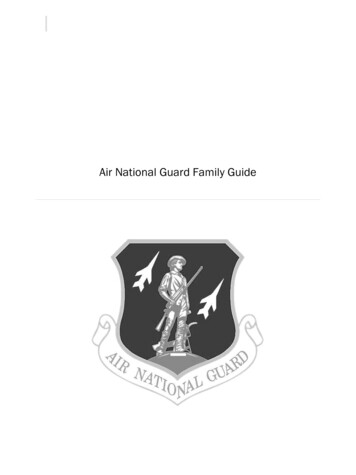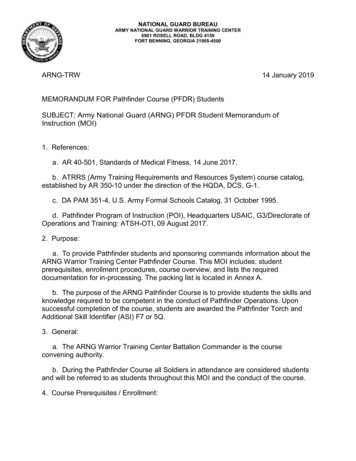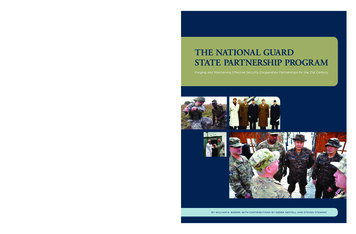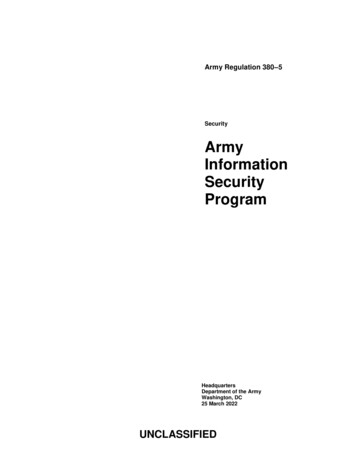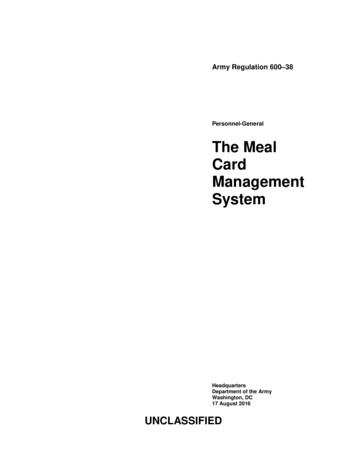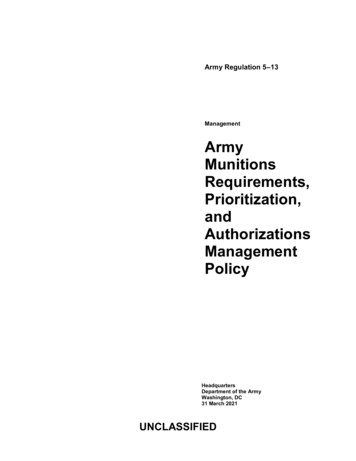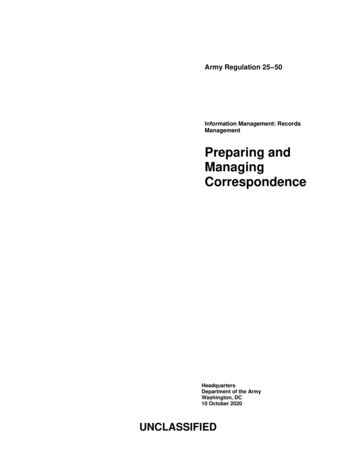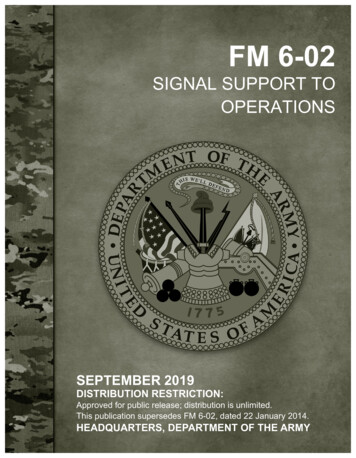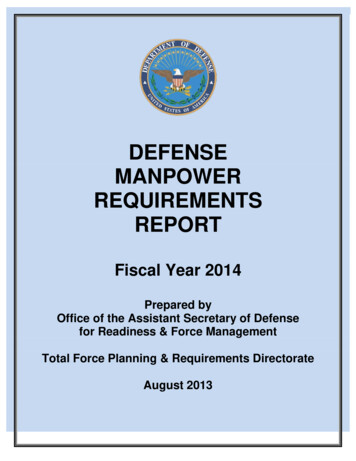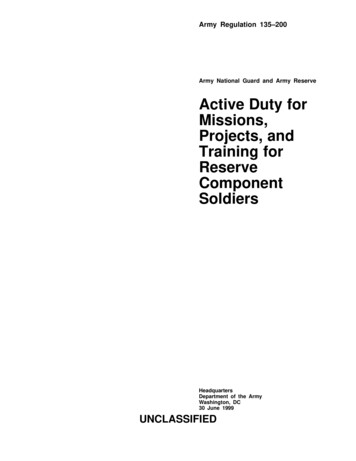
Transcription
Army Regulation 135–200Army National Guard and Army ReserveActive Duty forMissions,Projects, andTraining forReserveComponentSoldiersHeadquartersDepartment of the ArmyWashington, DC30 June 1999UNCLASSIFIED
SUMMARY of CHANGEAR 135–200Active Duty for Missions, Projects, and Training for Reserve Component SoldiersThis change 5--ooooDirects the reader to the authoritative guidance established in AR 600-110,Identification, Surveillance, and Administration of Personnel Infected withHuman Immunodeficiency Virus (HIV) pertaining to Human ImmunodeficiencyVirus (HIV) testing prior to entry on active duty or active duty for training.This change 4-Implements provisions of the National Defense Authorization Act for FiscalYear 1995 (public Law 103-337, 5 Oct 94), which repealed, transferred, orreenacted specific sections of law that impact on provisions of thisregulation.This change 3---oImplements provisions of Public Law 103-337, 5 Oct 94, which repealed,transferred, or reenacted specific section of law pertaining to active dutyfor training and active duty for special work referenced throughout theregulation.oRescinds paragraphs addressing early release from ADT or ADSW and directs theuser to the appropriate separation regulationsoSets forth the annual muster duty requirementoReduces unit administration by reducing the ADSW tour justification andapproval processoRequires DA DCSPER approval when a soldier with 17 or more years of AFS isbeing considered for an ADSW touroClarifies the appropriate use of ADSW and ADToRemoves the mandatory transfer requirement when unit soldiers volunteer forADSW which exceeds 1800 days, and makes other technical changes.oThis change 2---oClarifies existing policy in paragraphs 1-1b, 1-4a(1)(c), 1-4b(1)(c), 14c(1)(c), 1-5b, 1-6b, 1-6c, 1-6d, 1-7b, 1-7d, 1-7d(6), 1-8a(3), 1-11a(2), 111a(4), 1-11a(5.1), 1-11b(9), 1-18b, 3-1b, 4-1b, 4-1c(1), 4-2a, 6-1c, 6-4, 64b, 6-6a(9), 6-8a, 6-8d, and 6-8e.oEliminates "by name request" for readiness training. ARPERCEN will makeselections (para 4-3a(2)).
oProvides that a USAR soldier being ordered to an ADSW tour over 180 days orextended on an ADSW tour which will result in the tour being over 180 days willbe reassigned to the IRR (paras 6-1k, 6-7c(10) and fig 6-1).oEmphasizes requirement to provides milestones for all ADSW tour requestsregardless of tour length to include statement of how project or mission willbe completed if not completed by termination date of tour (paras 6-4b and fig6-1).oEstablishes requirement for all soldiers ordered to ADSW to sign statementprinted on DA Form 1058-R which addresses agreement to be released from tourwhen ADSW order has terminated (paras 6-6c and 6-6d).oRevises chapter 7 addressing involuntary active duty and active dutyextensions for administration of military justice.oRevises DA Form 1058-R to capture statement for signature.
Army Regulation 135–200HeadquartersDepartment of the ArmyWashington, DC30 June 1999Effective 30 July 1999Army National Guard and Army ReserveActive Duty for Missions, Projects, and Training for Reserve Component SoldiersHistory. This publication was originallyprinted on 30 June 1989. This electronicedition publishes the basic 1989 editionand incorporates Changes 1, 2, 3, 4 and 5.Change 1 was printed on 1 June 1990 andChange 2 was printed on 1 September1994. Change 3 to this regulation wasprinted on 17 June 1996. Change 3 wasauthenticated by Togo D. West, Jr.,Secretary of the Army. Change 4 wasprinted on 9 November 1998 and wasauthenticated by Louis Caldera, Secretaryof the Army. Change 5 was printed 30June 1999 and was authenticated by LouisCaldera, Secretary of the Army. Thispublication has been organized to make itcompatible with the Army electronicContentspublishing database. No content has beenchanged.civilian equivalent.Summary. This change implements provisions of the National Defense Authorization Act for Fiscal Year 1995 (publiclaw 103–337, 5 Oct 94), which repealed,transferred, or reenacted specific sectionsof law that impact on provisions of thisregulation.Army management control process.This regulation contains management control provisions, but does not identify keymanagement controls that must be evaluated. This regulation contains management control provisions, but does notidentify key management controls thatmust be evaluated.Applicability.a. This regulation applies to soldiers ofthe Army National Guard of the UnitedStates (ARNGUS) and the U.S. Army Reserve (USAR) not on active duty underAR 135–210; not on a temporary tour ofactive duty (TTAD), and not in an ActiveGuard Reserve (AGR) status (AR135–18). It also applies to Active Armyheadquarters, commands, and agencies responsible for ARNGUS and USAR soldiers on AT, ADT, ADSW, and IADT.b. During mobilization, procedures inthis publication can be modified to support policy changes as necessary.Proponent and exception authority.The proponent of this regulation is theDeputy Chief of Staff for Personnel(DCSPER). The DCSPER has the authority to approve exceptions to this regulation that are consistent with controllinglaws and regulation. The proponent maydelegate this approval authority, in writing, to a division chief within the proponent agency in the grade of colonel or theSupplementation. Supplementation ofthis regulation and the establishment ofcommand and local forms are prohibitedwithout prior approval from the Commander, U.S. Army Reserve PersonnelCommand, ATTN: ARPC–ZPO, 1 Reserve Way, St. Louis, MO 63132–5200.Interim changes. (Rescinded.)Suggested improvements. Users areinvited to send comments and suggestedimprovements on DA Form 2028 (Recommended Changes to Publications andBlank Forms) directly to HQDA, OCAR,ATTN: DAAR–PE, 2400 Army Pentagon,Washington DC, 20310–2400.Distribution. Distribution of this publication is made in accordance with the requirements of the initial distributionnumber (IDN) 092559 and intended forcommand levels C, D, and E for ActiveArmy; A, B, C, D, and E for Army National Guard and U.S. Army Reserve.(Listed by paragraph and page number)Chapter 1Introduction, page 1Purpose 1–1, page 1References 1–2, page 1Explanation of abbreviations and terms 1–3, page 1Responsibilities 1–4, page 1Restriction on tour length 1–5, page 2End strength accountability 1–6, page 2Reporting of ADT, ADSW, and TTAD tours exceeding 180 days 1–7, page 2AR 135–200 30 June 1999UNCLASSIFIEDi
Contents—ContinuedRequests for approval of ADSW tours exceeding 180 days 1–8, page 3Training delays and exemption and IADT for ROTC graduates 1–9, page 3Coordination of training 1–10, page 3Orders 1–11, page 4(Rescinded.) 1–12, page 6(Rescinded.) 1–13, page 6(Rescinded.) 1–14, page 6Army Physical Fitness Test (APFT) 1–15, page 6Uniform Code of Military Justice (UCMJ) 1–16, page 6Hospitalization or medical care of soldiers serving 1–17, page 6HIV testing before reporting for active duty or active duty for training 1–18, page 6Chapter 2Travel Time and Dates of Entry and Release from Duty, page 6Section IComputing Travel Time, page 6Authorized travel time 2–1, page 6Unauthorized travel time 2–2, page 6Section IIDates of Entry and Release from AT, ADT, or ADSW, page 6Entry on duty date 2–3, page 6Reporting date 2–4, page 7Release from duty date 2–5, page 7Early release 2–6, page 7Extension of ADT tours 2–7, page 7Chapter 3Annual Training and Required Active Duty for Training, page 7General 3–1, page 7Unit annual training 3–2, page 8Individual Mobilization Augmentation training 3–3, page 8Health Professions Scholarship Program 3–4, page 8Involuntary and voluntary AT of USAR Control Group (IRR) soldiers 3–5, page 9Muster duty 3–6, page 9Chapter 4Active Duty for Training, page 9General 4–1, page 9Selection of soldiers 4–2, page 9Use of ADT tours 4–3, page 10ADT without pay 4–4, page 10ADT requirements for tours and courses 4–5, page 10Exceptions to general requirements 4–6, page 11Applying for ADT 4–7, page 11Chapter 5Initial Active Duty for Training, page 13General 5–1, page 13IADT responsibilities 5–2, page 13Personnel ordered to IADT 5–3, page 13ROTC officer trainees 5–4, page 13Nonprior service enlistees 5–5, page 13Orders and related details 5–6, page 14iiAR 135–200 30 June 1999
Contents—ContinuedChapter 6Active Duty for Special Work, page 14General 6–1, page 14Proper use of ADSW tours 6–2, page 14Tour criteria 6–3, page 15Tour justification 6–4, page 15Approval authority 6–5, page 15Eligibility requirements 6–6, page 16ADSW tour length 6–7, page 17Status while on ADSW 6–8, page 17Separation documents 6–9, page 17Chapter 7Involuntary Active Duty and Active Duty for Training for Administrative of the Uniform Code of MilitaryJustice, page 21Section IGeneral, page 21General 7–1, page 21Scope 7–2, page 21Section IIRetention on Active Duty or Active Duty for Training, page 21Retention on AD or ADT while on self-terminating orders 7–3, page 21Reason for retention 7–4, page 21Orders 7–5, page 21Disposition of soldiers following court adjournment 7–6, page 22Section IIIOrder to Active Duty for Administration of Uniform Code of Military Justice, page 22Involuntary order to active duty 7–7, page 22Purpose 7–8, page 22Involuntary active duty orders 7–9, page 22Failure to report for AD 7–10, page 23Disposition of soldiers following court adjournment 7–11, page 23UCMJ Jurisdiction 7–12, page 23Chapter 8Disposition of Individual Soldiers on Active Duty (AT, IADT, ADT, and ADSW) at time of Mobilization,page 24Purpose 8–1, page 24Responsibility 8–2, page 24ARNGUS and USAR unit personnel on AT, ADT, IADT, and ADSW 8–3, page 24IMAs on AT, ADT, and ADSW 8–4, page 25IRR soldiers on AT, ADT, IADT, or ADSW 8–5, page 25Soldiers in specialized medical training 8–6, page 25AppendixesA.References, page 26B.Letter of Instruction (See para 1–11f for use by orders issuing authority.), page 29Table ListTable 1–1: Distribution of training orders, page 4Table 4–1: Where to send DA Form 1058-R, page 12AR 135–200 30 June 1999iii
Contents—ContinuedTable 6–1: A Guide to the types of duty tours performed in ADT and ADSW status1 (See notes.), page 18Figure ListFigure 6–1: Sample for preparing ADSW tour request, page 20Figure 7–1: Affidavit of Service by Mail, page 24GlossaryivAR 135–200 30 June 1999
Chapter 1Introduction1–1. Purposea. This regulation prescribes policies and procedures For ordering Army National Guard of the United States(ARNGUS) and United States Army Reserve (USAR) soldiers to-—(1) Annual training (AT).(2) Active duty for training (ADT).(3) Initial active duty for training (IADT).(4) Active duty for special work (ADSW).b. As used in this regulation, Major Army Commands (MACOMs) are identified as—(1) U.S. Forces Command (FORSCOM).(2) U.S. Army Training and Doctrine Command (TRADOC).(3) U.S. Army Pacific (USARPAC).(4) U.S. Army Europe and Seventh Army.(5) U.S. Army South (USARSO).(6) (Rescinded.)(7) U.S. Army Special Operations Command (USASOC).1–2. ReferencesRequired and related publications and prescribed and referenced forms are listed in appendix A.1–3. Explanation of abbreviations and termsAbbreviations and special terms used in this regulation are explained in the consolidated glossary.1–4. Responsibilitiesa. The Director, Army National Guard (DARNG) will—(1) Be final approval authority for any ADSW tour by an ARNGUS soldier when one of the conditions in (a)through (c) below exists. This authority will not be further delegated.(a) The tour exceeds 180 days.(b) The tour will result in the soldier being ordered to a combined total of over 180 days of ADSW within a fiscalyear (FY).(c) The tour will result in the soldier being ordered to any combination of ADSW and Temporary Tours of ActiveDuty (TTAD) (AR 135–210) totaling over 180 days within an FY.(2) Have waiver authority for the 60-day break required by paragraph Assign qualified ARNGUS soldiers to fillapproved positions and issue ADSW orders except as stated in chapter 6. This authority may be delegated to Stateadjutants general (AG).(3) Establish and implement the accounting procedures for ARNGUS soldiers on ADSW who must be counted inthe ARNGUS Active Guard Reserve (AGR) end strength.(4) Report quarterly to HQDA (DAPE–MPE) the number of ARNGUS soldiers who have been ordered to or whohave served over 180 days (including travel time) of ADSW and/or TTAD within the current FY.(5) Report annually to HQDA (DAPE–MPE) the number of ARNGUS soldiers who have been ordered to or whohave served over 180 days (including travel time) of ADT during the previous FY. (AT performed under title 32, U.S.Code is not reportable.)b. The Chief Army Reserve (CAR) will—(1) Be final approval authority for any ADSW tour by an Individual Ready Reserve (IRR) soldier when one of theconditions described in (a) through (c) below exists. This authority will not be further delegated.(a) The tour exceeds 180 days.(b) The tour will result in the soldier being ordered to a combined total of over 180 days of ADSW within an FY.(c) The tour will result in the soldier being ordered to any combination of ADSW and TTAD totaling over 180 dayswithin an FY.(2) Have waiver authority for the 60-day break required by paragraph Report quarterly to HQDA (DAPE–MPE), thenumber of IRR soldiers who have been ordered to or who have served over 180 days (including travel time) ofADSWand/or TTAD within the current FY.(3) Report annually to HQDA (DAPE–MPE) the number of IRR soldiers who have been ordered to or who haveserved over 180 days (including travel time) of ADT during the previous FY.(4) Establish and implement accounting procedures for IRR soldiers on ADSW who must be counted in the USARActive Guard Reserve (AGR) end strength.c. The MACOM commander will—AR 135–200 30 June 19991
(1) Be final approval authority for any ADSW tour by an assigned USAR troop program unit (TPU) soldier whenone of the conditions described in (a) through (c) below exists. This authority will not be further delegated.(a) The tour exceeds 180 days.(b) The tour will result in the soldier being ordered to a combined total of over 180 days of ADSW within an FY.(c) The tour will result in the soldier being ordered to any combination of ADSW and TTAD totaling over 180 dayswithin an FY.(2) Have waiver authority for the 60-day break required by paragraph Report quarterly to HQDA (DAPE–MPE), thenumber of assigned USAR TPU soldiers who have been ordered to or who have served over 180 days (including traveltime) of ADSW and/or TTAD within the current FY.(3) Report annually to HQDA (DAPE–MPE) the number of assigned USAR TPU soldiers who have been ordered toor who have served over 180 days (including travel time) of ADT during the previous FY.(4) Establish and implement, in coordination with OCAR, accounting procedures for TPU soldiers on ADSW whomust be counted in the USAR AGR end strength.d. The commanders listed below will have orders issuing authority as specifically prescribed in chapters 3 through 6.(1) Major Army command (MACOM) commanders.(2) Commanding General, U.S. Army Reserve Personnel Command (CG, AR–PERSCOM).(3) DARNG.(4) State adjutants general.(5) Major U.S. Army Reserve command (MUSARCs) commanders.(6) Area commanders.(7) Military Entrance Processing Stations (MEPS) commanders.1–5. Restriction on tour lengthAn ARNGUS or USAR soldier will not be placed on or extended on an ADSW tour under this regulation without priorapproval as prescribed in paragraph 1–8 if—a. The duties or milestones exceed 180 days. This limitation also applies to extensions of existing ADSW tours.b. The new or extended tour will result in the soldier being ordered to over 180 days of ADSW within an FY or anycombination of ADSW and TTAD totaling over 180 days within an FY.1–6. End strength accountabilitya. For the purpose of end strength accounting under this regulation, compilation of tour days must include traveltime.b. Unless HQDA (DAPE–MPE) approves exemption, an ARNGUS or USAR soldier will be counted against theappropriate AGR end strength if any one of the following conditions is met:(1) Soldier is on or has been ordered to an ADSW tour exceeding 180 days and is on ADSW on 30 September.(2) Soldier will accumulate over 180 days of ADSW within an FY and is on ADSW on 30 September.(3) Soldier will accumulate any combination of ADSW and TTAD totaling over 180 days within an FY and is onADSW on 30 September.c. An ARNGUS or USAR soldier who is on a TTAD exceeding 180 days or who has been ordered to over 180 daysof TTAD or any combination ofADSW and TTAD totaling over 180 days within an FY and is on a TTAD on 30September will be counted in the Active Army (AA) end strength. CG, U.S. Total Army Personnel Command (CG,PERSCOM) will establish and implement procedures to account for soldiers who must be counted in the AA endstrength under this paragraph. Note. Accountability under this paragraph is not to be interpreted to mean the soldiergains AGR or AA status. Soldiers meeting the criteria of paragraph b or c above must be counted in the appropriateend strength report submitted to Congress each fiscal year.1–7. Reporting of ADT, ADSW, and TTAD tours exceeding 180 daysa. For the reporting requirements of this regulation, compilation of tour days must include travel time.b. Approval authorities (para 1–8) will report quarterly to HQDA (DAPE–MPE) the number of soldiers by nameand social security number who must be counted in the AGR or AA end strength. Soldiers not accounted for inparagraph 1–6 who have been ordered to or have served over 180 days of ADSW , TTAD , or any combination ofADSW and TTAD totaling over 180 days within the current FY must also be reported to HQDA. (See d below forreporting categories.) Reports are due the last working day of the first month of each quarter.c. Soldiers who exceed a 180-day accumulation of ADT and/or IADT within an FY must also be reported to HQDA(DAPE–MPE). Approval authorities (para 1–8) will submit an annual report (NLT 1 December) of the number ofsoldiers under their jurisdiction who have been ordered to or who have served over 180 days of ADT and/or IADT inthe previous FY . (See d below for reporting categories.)d. Soldiers not counted in the AGR or AA end strength who accumulate over 180 days of ADSW, ADT, TTAD, or2AR 135–200 30 June 1999
any combination of ADSW, and TTAD totaling over 180 days within an FY will be reported in one of the categoriesof (1) through (6) below.(1) Recruit and specialized training.(a) All enlisted initial entry training (IET) where basic and advanced individual training (AIT) combined will exceed180 days.(b) Split IET where AIT exceeds 180 days.(c) Military occupational specialty (MOS), Specialty Skill Identifier (SSI) (also known as area of concentration(AOC)), or ASI producing training, other than IET, that exceeds 180 days, i.e. Special Operations (Special Forces,Civil Affairs, PSYOPS), Military Intelligence, medical, or signal school.(d) Language training.(e) Any of the above plus indoctrination training that results in an accumulation of more than 180 days.(2) Flight training.(a) For officers, this includes aviation branch and AOC 67J, warrant officer aviators.(b) Officers who will go to the officer basic course (OBC) then into flight training.(c) Enlisted personnel in career management field (CMF) 67.(d) Any of the above plus indoctrination training if total training exceeds an accumulated total of 180 days.(3) Professional training at military institutions. This includes training such as—(a) Officer advance course.(b) Command and General Staff College.(c) Army War College.(d) Specialized medical training.(4) Professional training at civilian institutions. This includes training at any approved civilian institutions.(5) Officer acquisition training. This includes OBC and officer candidate school (OCS) soldiers with follow-ontraining (to include indoctrination training) that exceeds 180 days.(6) Other active duty. This includes soldiers who exceed a cumulative total of 180 days or more of ADSW, TTAD,or any combination of ADSW and TTAD totaling over 180 days within an FY, but are not accounted for in one of theabove categories, the AGR end strength, or the AA end strength (para 1–6).1–8. Requests for approval of ADSW tours exceeding 180 daysa. This paragraph applies to soldiers being ordered to ADSW tours or extensions of these tours which will—(1) Exceed 180 days.(2) Result in the soldier being ordered to over 180 days of ADSW within an FY.(3) Result in the soldier being ordered to any combination of ADSW and TTAD totaling over 180 days within anFY.b. To ensure compliance with the law and accuracy in accounting and reporting (paras 1–6 and 1–7), tours describedabove are not authorized without the following approval: (Approval authorities may further delegate this authority onlyas designated in para 1–4.)(1) DARNG for ARNGUS soldiers.(2) CAR for IRR soldiers.(3) MACOM commander for assigned USAR TPU soldiers.c. Requests will be sent through command channels to the appropriate approval authorities in b above. Requestswill—(1) State source of funding.(2) Identify the AGR position to remain vacant during the ADSW tour, when appropriate (para 1–6).(3) Identify the proper reporting category of paragraph 1–7 if the soldier is not counted in the AGR end strength.1–9. Training delays and exemption and IADT for ROTC graduatesa. To order Reserve Officers’ Training Corps (ROTC) graduates to IADT, follow the procedures in AR 140–9.b. To delay or exempt personnel from entry on ADT or IADT, follow the procedures in AR 601–25.1–10. Coordination of traininga. State AGs will coordinate with the DARNG concerning allocations, reporting dates, and other administrativematters relating to ADT, IADT, and ADSW.b. Before issuing ADT or IADT orders for formal courses of instruction, the authorizing command will assure thatthe proper allocation for such training has been approved.c. Before issuing ADT orders for other than formal courses of instruction, the authorizing commander will getapproval of the element sponsoring training for the soldier concerned.AR 135–200 30 June 19993
1–11. OrdersOrders for U.S. Army Reserve (USAR) soldiers will be prepared according to this regulation and AR 310–10. Ordersfor Army National Guard of the United States (ARNGUS) soldiers will be prepared per NGR 310–10, NGR 600–100,NGR 600–200, and this regulation.a. Authority.(1) The authorities in (a) through (f) below will issue AT, ADT, and IADT orders for ARNGUS and USAR soldiersunder their jurisdiction and within funds availability priority limits.(a) MACOM commanders.(b) MUSARC commanders.(c) Area commanders.(d) State AGs.(e) CG, ARPERCEN.(f) MEPS commanders.(g) Subordinate commanders specifically delegated authority by the authorities noted in (a) through (f) above.(2) ADT may be performed by ARNGUS and USAR soldiers with the pay and allowances provided by law, or withthe specific consent of the soldier concerned without pay when circumstances of paragraph 4–4 exist. Duty without paywill be considered for all purposes other than pay, as if it were duty with pay. Orders for soldiers to perform ADTwithout pay may be issued by ARPERCEN for IRR and IMA soldiers; the appropriate MUSARC for TPU soldiers; orthe State AG for ARNGUS soldiers. Note. ADT without pay is ADT without basic pay. Travel pay and allowances areauthorized except for key personnel assigned to the Standby Reserve (Active Status List).(3) At the request of DARNG, State AGs may issue ADSW orders.(4) MACOM commanders (for TPU soldiers) and CG, ARPERCEN (for IRR and IMA soldiers) may issue ADSWorders for USAR soldiers under their jurisdiction. FORSCOM may delegate this authority consistent with paragraph6–5d.(5) ADT, IADT, and ADSW orders will clearly cite section 12301(d), title 10 U.S. Code (10 USC 12301(d)) as theauthority for ordering a soldier to active duty.(6) AT orders for USAR units will clearly cite 10 USC 12301(b) as the authority for periods of AT.(7) AT orders for ARNGUS units will cite 32 USC 502(a) as the authority for periods of AT. This is unless suchunit’s AT will be performed outside the United States or its territories. AT orders for ARNGUS units performingtraining outside the United States or its territories will cite 10 USC 12301(b) as the authority.Table 1–1Distribution of training ordersNumber of copiesAT For ControlAll Other TrainingGroup MembersRecipientMember1010Unit of attachment12Appropriate State adjutant general when attached to an ARNGUS unit12Fiscal officer whose funds are chargeable12Intermediate commander when medical fitness exam is required-5Reception station commander or commander of IADT attachment (with SF 88 (Report of Medical Examination) and SF 93 (Report of Medical History) if appropriate)-7Commander of the soldier’s assigned USAR unit-5Area commander having administrative jurisdiction over the soldier-2Area commander of the training station when trained in a different area command-2Proponent agency for Individual Mobilization Augmentees-2School commandant where MOS course is conducted-2MPRJ when orders are for 90 or more days of training (destroy extra copies after training)-104AR 135–200 30 June 1999
(8) AT orders for individual USAR soldiers will clearly cite 10 USC 10147 as the authority for periods of AT.(9) Soldiers on AT, ADT, IADT, and ADSW orders under 10 USC are subject to the Uniform Code of MilitaryJustice (UCMJ). ARNGUS soldiers on AT orders under 32 USC, are not subject to UCMJ; however, they are subjectto the military code of the State or Territory of whose National Guard they are soldiers.(10) Tours governed by this regulation are typically of short duration. Orders which place a soldier on active dutyspecify that release will occur at the end of the tour. None of the following provisions will apply to soldiers who comewithin 2 years of retirement eligibility during a period of AT, ADT, or IADT (10 USC), or AT (32 USC):(a) The “sanctuary” provisions of 10 USC 12686.(b) Release procedures contained in AR 600–8–24, paragraph 2-25e(2); or(c) Any other requirements for retention.b. Required information. Prepare AT, ADT, IADT, and ADSW orders according to standard formats in AR 310–10,and NGR 310-10. Include the—(1) Permanent home address. The permanent home address (home of record) is the actual place in which the soldierlives. This is different from a temporary address or the address of a person or institution used for forwarding purposesonly. The place listed as the permanent home address will constitute the “home” or “home of record” as used in JointFederal Travel Regulations (JFTR) and the Department of Defense Military Pay and Allowances Entitlements Manual(DODPM). Orders issuing agencies may correct a home of record by amendment if it will be published before thesoldier enters on duty. Orders will not be amended after the soldier enters on duty unless approved by DARNG or CG,ARPERCEN, as applicable.(2) Length of training. Express length of training in days (i.e. 12 days or 120 days). The period of training will notinclude travel time to or from the duty station.(3) Reporting date and time. Show the reporting date and time of day on the order but not the effective date of entryon duty. A “first day of training date” will also be shown in AT orders. (See chap 2, sec I for travel information andsec II for dates of entry and release from ADT or AT.)(4) Military Personnel Records Jacket, U.S. Army (MPRJ) mailing address. Specify the mailing address on the orderwhere the MPRJ will be sent when a soldier is ordered to active duty for 90 days or more. Also specify in the order thestatement “MPRJ will be forwarded per AR 640–10 to the Personnel Service Center (unit and address) for administration while on ADT or ADSW.” Return the MPRJ to the ARNGUS or USAR record’s custodian when the training tourends.(5) Accounting information.(6) Type of duty to perform. Type of duty to be performed (i.e. AT, ADT, IADT, or ADSW.)(7) Consent for ADT, IADT, or ADSW. Insert the words “with consent of the soldier” after the authority lead linewhen training is voluntary. Consent for IADT is understood when a soldier volunteers for enlistment or appointment.In ordering ARNGUS soldiers to periods of ADT, IADT, or ADSW, the consent of the Governor or other appropriateState or territorial authority is understood but will be included in the order as shown in AR 310–10.(8) Waiver statement for exceeding 180 days of ADSW or ADSW and TTAD combined within an FY. Whenapplicable, orders will contain the following statement in “Additional Instruction”(9) Waiver. An ADSW order requires a waiver if ADSW is scheduled in the first 2 months of the FY and the soldierhas not had a break of 60 continuous calendar days following the last day of an ADSW tour or TTAD in the previousFY. This waiver of the 60–day break rule is needed only when the soldier has accumulated more than 30 days ofADSW, TTAD, or any combination of ADSW and TTAD totaling over 30 days during the last quarter of the previousFY. If waived, the following statement will be placed in “Additional Instructions”c. Unauthorized entries. The following entries will not be included on training orders:(1) Travel by privately owned vehicle (POV) for IADT tours.(2) Temporary duty pending further orders (TDPFO).d. Distribution. When possible, send the soldier enough copies of training orders 30 days before the reporting dateas shown in table 1-1. Make other distribution per AR 310–10, NGR 310–10, and as required by DARNG, areacommanders, or CG, ARPERCEN. !e. Amendment or revocation. Publish amended or revocation orders as soon as possible, using the format shown inAR 310–10 and NGR 310–10. Distribute amendments or revocations in the same manner as the original order. Anexception is that the “member concerned” copy will not be shown on the distribution if death
the Army National Guard of the United States (ARNGUS) and the U.S. Army Re-serve (USAR) not on active duty under AR 135-210; not on a temporary tour of active duty (TTAD), and not in an Active G u a r d R e s e r v e ( A G R ) s t a t u s ( A R 135-18). It also applies to Active Army headquarters, commands, and agencies re-
